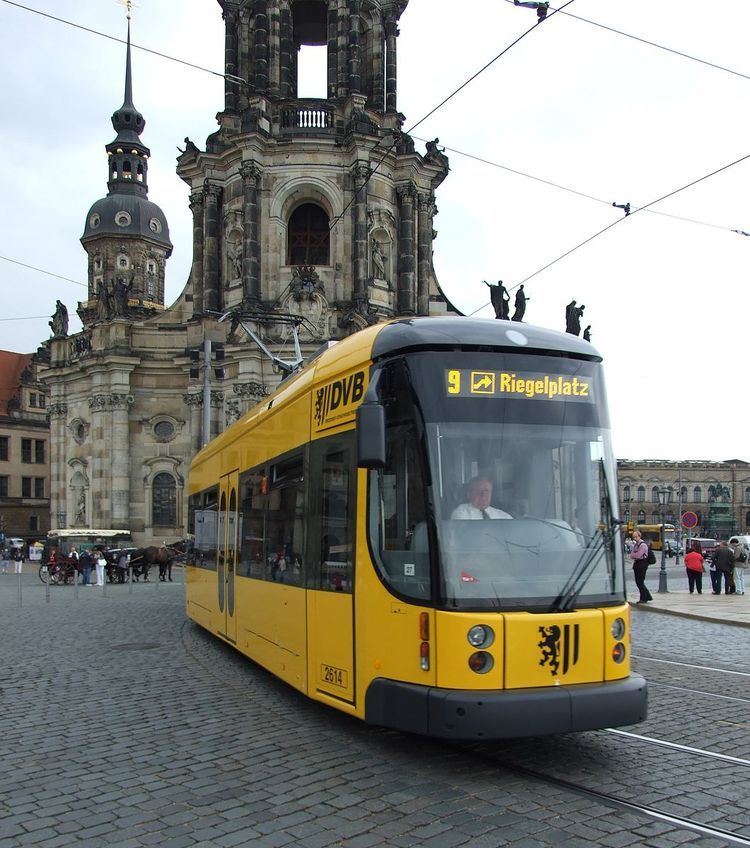 | ||
The Dresden tramway network (German: Straßenbahnnetz Dresden) is a network of tramways forming the backbone of the public transport system in Dresden, a city in the federal state of Saxony, Germany. Opened in 1872, it has been operated since 1993 by Dresdner Verkehrsbetriebe (DVB).
Contents
As of 2008, the network comprised 12 tram lines, with a total line length of approximately 210 kilometres (130 mi) and a total route length of 132.7 kilometres (82.5 mi). There was 291.6 kilometres (181.2 mi) of track, which translated into 132.7 kilometres (82.5 mi) of actual tram line, serving 154 tram stops,
History
The origins of the Dresden tramway network can be traced back to the year 1872, when the first horse-drawn line opened between the city centre and the former village of Blasewitz, now a borough of Dresden.
Lines
The Dresden tramway network is a mixed system of traditional street running, especially in the inner city boroughs close to the city centre, and modern light rail. The network uses the unusual gauge of 1,450 mm (4 ft 9 3⁄32 in), which is just 15 mm or 19⁄32 inch wider than 1,435 mm (4 ft 8 1⁄2 in) standard gauge.
In recent years, street running has been replaced by independent right-of-way arrangements wherever possible, and new extensions created in the same form. In November 2008, a 2.8-kilometre (1.7 mi) extension of line 7 was opened from Gorbitz to Pennrich, in Dresden's south eastern suburbs. In May 2011, a 1.6-kilometre (0.99 mi) extension of line 10 opened from Friedrichstrasse to the city's Messe or exhibition centre, involving construction of a 315-metre (1,033 ft) long, 15-metre (49 ft) wide and 5.4-metre (18 ft) high bridge across the floodplain of the River Elbe.
Unlike many other German cities of comparable size, no stadtbahn style tunnel sections or high platform stops have been created. However many tram stops have been rebuilt so as to be fully accessible to physically disabled persons, and to allow level boarding to the low floor trams that now operate most services.
Different lines can be identified by a line number and a colour code. The current lines are:
Future plans, as part of the Stadtbahnprogrammn 2020, include 14.9 kilometres (9.3 mi) of new tram line, with work starting in 2014. Some 10.5 kilometres (6.5 mi) would be on reserved track, and the new lines would replace bus lines 61 and 62, some of the city's busiest, with an estimated cost of 223 million euros. The new lines comprise:
On all tram lines except line 4, a general 10-minute headway is offered on weekdays, extending to 15 minutes on Saturday, Sunday and in the evening. On the main routes through the inner city, where different lines intertwine, vehicles run up to every two minutes. Line 4, which extends a considerable distance beyond the city boundary to the towns of Radebeul, Coswig and Weinböhla, operates the standard 10 or 15 minute interval service as far as Radebeul West, and a 30-minute service beyond that to Coswig and Weinböhla.
Fleet
As of 2008, Dresden's tram fleet was made up of 166 modern tramsets (with 31 older trams). Most of the trams operating in Dresden are articulated low floor cars, of two different basic designs, each of which has several variants.
The first generation of low floor cars was built by Deutsche Waggonbau (DWA) in Bautzen between 1995 and 2002; both 6 and 8 axle variants exist. The second generation of low floor cars have been built since 2003 by Bombardier Transportation, also in Bautzen, and are of that manufacturer's Flexity Classic design; both 8 and 12 axle variants exist. The articulated cars vary in length from 30 to 45 metres (98 to 148 ft) long; all run as single car sets.
The fleet used to be composed of ČKD Tatra trams that provided service towards the end of the GDR era. At present some Tatra T4 cars built between 1968 and 1984 are still in service, but it is intended that they will all be replaced by 2010. The Tatra cars are all high floor, precluding level boarding from tram stops, and run in two car sets with a set length of some 30 metres (98 ft).
The DVB tram fleet operates out of three depots; at Gorbitz on routes 2,6 and 7 in south west Dresden, at Trachenberge on route 3 in the north-west, and Reick on routes 1, 9 and 13 in the south-east. Gorbitz is new facility opened in 1996 and includes a new central workshops. Trachenberge and Reick are older facilities that have both been heavily rebuilt to similar standards, whilst several other older depots have been closed. The former central workshops at Trachenberge, adjacent to the current depot, now house the Dresden Tram Museum, which has a collection including examples of many former Dresden trams.
CarGoTram
The CarGoTram is a freight carrying tram that supplies Volkswagen's Transparent Factory, crossing the city. The two trams, up to 60 metres (200 ft) long, are the longest vehicles allowed to use roads in Dresden. The connection by tram was established to reduce the number of trucks used. The factory is located to the east of the city centre, next to the Großer Garten, whilst the distribution depot that loads the parts is to the west of the city centre.
